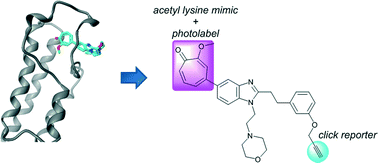Direct photocapture of bromodomains using tropolone chemical probes†
Abstract
Medicinal chemistry techniques, including structure-based molecular design, fragment replacement and synthetic library enablement, were used to create potent

* Corresponding authors
a
Worldwide Medicinal Chemistry, Pfizer, 610 Main Street, Cambridge, MA, USA
E-mail:
erik.hett@pfizer.com, lyn.jones@pfizer.com
b Worldwide Medicinal Chemistry, Pfizer, Eastern Point Road, Groton, CT, USA
c Primary Pharmacology Group, Pfizer, Eastern Point Road, Groton, CT, USA
d Structural Biology and Biophysics, Worldwide Medicinal Chemistry, Pfizer, Eastern Point Road, Groton, CT, USA
e Rare Disease Research Unit, Pfizer, 610 Main Street, Cambridge, MA, USA
Medicinal chemistry techniques, including structure-based molecular design, fragment replacement and synthetic library enablement, were used to create potent

 Please wait while we load your content...
Something went wrong. Try again?
Please wait while we load your content...
Something went wrong. Try again?
E. C. Hett, E. L. Piatnitski Chekler, A. Basak, P. D. Bonin, R. A. Denny, A. C. Flick, K. F. Geoghegan, S. Liu, M. T. Pletcher, P. Sahasrabudhe, S. C. Salter, I. A. Stock, A. P. Taylor and L. H. Jones, Med. Chem. Commun., 2015, 6, 1018 DOI: 10.1039/C5MD00070J
To request permission to reproduce material from this article, please go to the Copyright Clearance Center request page.
If you are an author contributing to an RSC publication, you do not need to request permission provided correct acknowledgement is given.
If you are the author of this article, you do not need to request permission to reproduce figures and diagrams provided correct acknowledgement is given. If you want to reproduce the whole article in a third-party publication (excluding your thesis/dissertation for which permission is not required) please go to the Copyright Clearance Center request page.
Read more about how to correctly acknowledge RSC content.
 Fetching data from CrossRef.
Fetching data from CrossRef.
This may take some time to load.
Loading related content
